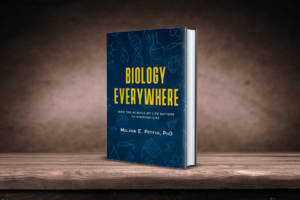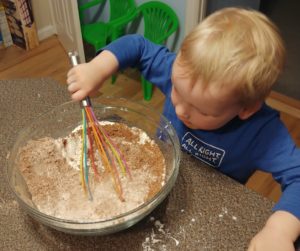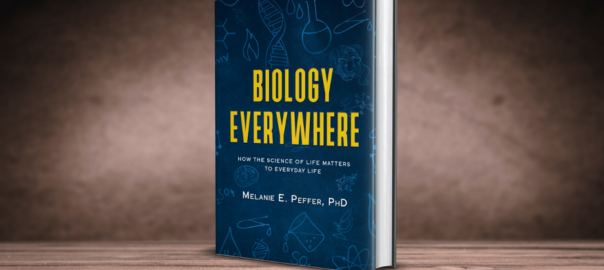by Melanie E. Peffer, PhD
Dr. Melanie Peffer has a BS and PhD in molecular biology from the University of Pittsburgh and completed a postdoctoral appointment in learning sciences from Georgia State University. She combines her expertise in molecular biology and the learning sciences to study how people learn, understand, and engage with biology content.
When am I EVER going to need to know this?
We’ve all heard students say that before. It’s even more pertinent now in the digital age when so many of the concepts we teach in classrooms are a simple Google search away.
It’s not a matter of if a student needs to know something – but when and how they’ll need the information they learn in our classrooms.
When the time comes in which a student needs to engage with a scientific issue in the course of their daily lives, how can we ensure that students leave the classroom feeling empowered to engage?

Biology Everywhere bridges the gap between the classroom and practical biology knowledge needed in the real world. Copies are available at www.biologyeverywhere.com
I wrote Biology Everywhere: How the science of life matters to everyday life with this question in mind. The bedrock of my book, and the associated online course, seeks to empower individuals to engage with science issues by presenting them through the lens of our daily experiences and in connection with other disciplines. This is especially important to consider in light of the COVID19 pandemic – which is forcing society to engage with science issues on a daily basis.
Teaching science in connection with our daily experiences.
Science content can feel abstract to students. That fuels the idea that science is inaccessible, and drives students away from engaging in the classroom. They feel like they can’t do it, or aren’t smart enough and so they shut down. They disengage with scientific issues, not just in the classroom but in society as well, and may even choose to align what they consider to be good science with their political party affiliation.
When we think about the applicability of science to our daily experiences, the content becomes relatable and therefore more accessible. This approach is also more student driven, too. One easy lesson that can be done in person or remotely is to task students with finding something interesting or mysterious to them and ask a question about it. Then, build a science lesson around the child’s question. Allowing students to ask their own questions is also a powerful way to deepen student learning and engagement.

Cooking and baking is rife with opportunities to talk about practical applications of chemistry.
Kitchen chemistry is very accessible. I cook with my son – and he gets very excited to see the bubbles that appear when we add baking powder to the mix when making pancakes. It becomes a very easy science lesson to talk about the bubbles that form make the pancake fluffy. You can adapt this for an older student by talking about the exact chemical reaction that is occurring. If you aren’t sure, this is an opportunity to look it up and learn together.
In the context of biology, I look towards big issues in today’s society to highlight and discuss with students. When I cover ecology, I demonstrate how ecological principles apply to our daily lives – such as issues around conservation. For example, what makes reusable eco-friendly or not and some of the trade-offs around reusable products. You can watch this video on plastic versus reusable bags that is based on my book here.
Teaching Science in Connection with Other Disciplines
If you think about a traditional school, there are science teachers in a science classroom … the music teacher in the band room … the history teacher in the history classroom. And the history teacher is going to teach … well, history!
In the real world though, the lines between disciplines are much more blurry. Helping teachers connect lessons in their disciplines to science content is a major thrust of Chris Woods’ work with dailySTEM and his podcast series, STEM Everyday.
How about in the context of biology? What if I said art was foundational to biology?
We hear about the STEAM movement – adding an A for arts to STEM. But what does that really mean?
When thinking about how science really works in the real world, it’s fundamentally a creative process. Coming up with new questions to ask, methods for studying the world, and making sense of the data we get – it all requires creativity and thinking outside the box.
The fine arts have had a measurable impact on biological science as well. Take for example Santiago Ramon y Cajal’s drawings of neurons. His ability to accurately draw neurons with his artist’s eye towards form and function led to one of the most important discoveries in the history of neuroscience: that the neuron is the functional unit of the brain, a discovery that continues to inform modern neuroscience.
Or John Audobon’s paintings of birds. Some of the birds he painted, like the Carolina parakeet, have gone extinct – so his paintings are important parts of natural history.
Conversely, biology also tells us about our experience with the arts, too. Why do we feel chills when listening to music? Dopamine release. Dopamine is a neurotransmitter, or chemical that is released by neurons to communicate with one another. Dopamine regulates motivation and pleasure – including the pleasurable responses we have to music. Scientists found that if you inhibit dopamine release, people enjoy music less. If you do the opposite and increase dopamine release, music is even more enjoyable.
Making Science Accessible in Light of the COVID19 Pandemic
The COVID19 pandemic is forcing people to engage with the realities of how science works – and for some, it’s their first experience with the messy, iterative, constantly evolving nature of authentic science inquiry.
The pandemic brought the question “when am I EVER going to need to know this” into a new light. It can’t be avoided or subverted – as a society, we’re grappling with real scientific (and mathematical) issues.
Whether it’s mask wearing, applying the basic principles of life to define what a virus is – and why we can’t treat it with antibiotics, or understanding the process of developing and testing a COVID19 vaccine or treatments, it is necessary for us all to engage with these issues and make informed decisions.
Where to start? We can teach the student in front of us – but also recognize that the general public is struggling too. I suggest we start with building the confidence in science first – present it through the lens of our daily experiences and in connection with other disciplines. Then, when the time comes to engage with scientific issues, people feel empowered to engage and make an informed decision.



